Stay Home Sakoku: The Hikikomori Project was a 7-day ‘live in’ performance and online chat that took place at West Space in March 2012. In this work, artist Eugenia Lim explored introverted human relationships and the interface between real and virtual worlds. Taking the Japanese phenomenon of hikikomori or ‘shut in’ syndrome as its framework, Eugenia sealed herself in a bedroom-style installation, inhabiting a small back gallery of West Space. For the duration of the performance, she relied on the generosity of strangers for food and survival. The performance was networked, so her only contact with the outside world was through a web portal or ‘hiki-site’.
Eugenia Lim is a Melbourne-based interdisciplinary artist working with video, performance and installation to explore race, identity and representation. Recently, her practice has included live performances mediated by technology in which she performs identities. Lim has exhibited at the Tate Modern, FACT Liverpool, Queensland Gallery of Modern Art, and the Australian Centre for the Moving Image. Peril spoke to Lim recently about Stay Home Sakoku in relation to binary concepts of inside/outside, real/virtual, day/night and the elastic nature of time.
www.eugenialim.com
www.stayhomesakoku.com
www.stayhomesakoku.tumblr.com
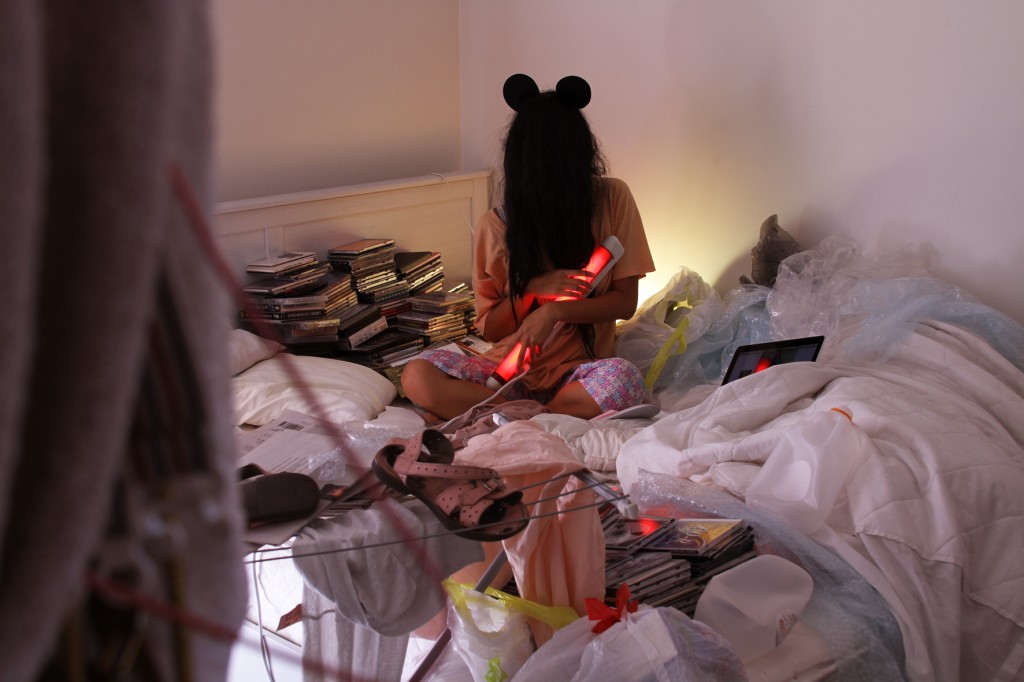
PERIL: What inspired you to work with the concept of hikikomori or ‘shut in’ syndrome?
EUGENIA: I’ve long been attracted to stories, real and mythological, of people on the margins of society. While researching NOWHERELAND: The Paris Human Flesh Incident, an installation work exploring the story of real-life Japanese cannibal Issei Sagawa, I came across a documentary about hikikomori. I became fascinated by this invisible but increasingly significant social phenomenon in which a younger generation was ‘shutting themselves away from the sun’. Hikikomori, by Japanese government accounts at the time of my researching, was affecting up to 1 million people (mostly young men). I started reading and researching, tracing the hikikomori phenomenon back to the Shinto myth of Amaterasu, the sun goddess, who in fact shut herself away in a cave, plunging the whole world into darkness, which led me to make the video work Nest, with incredible butoh performer Yumi Umiumare. Personally, as a young woman of Chinese descent, living in Australia in a culture in which social reclusiveness is definitely not a huge part of the mainstream psyche, I was interested to see how I could make visible or give tangible shape to such a hidden world.
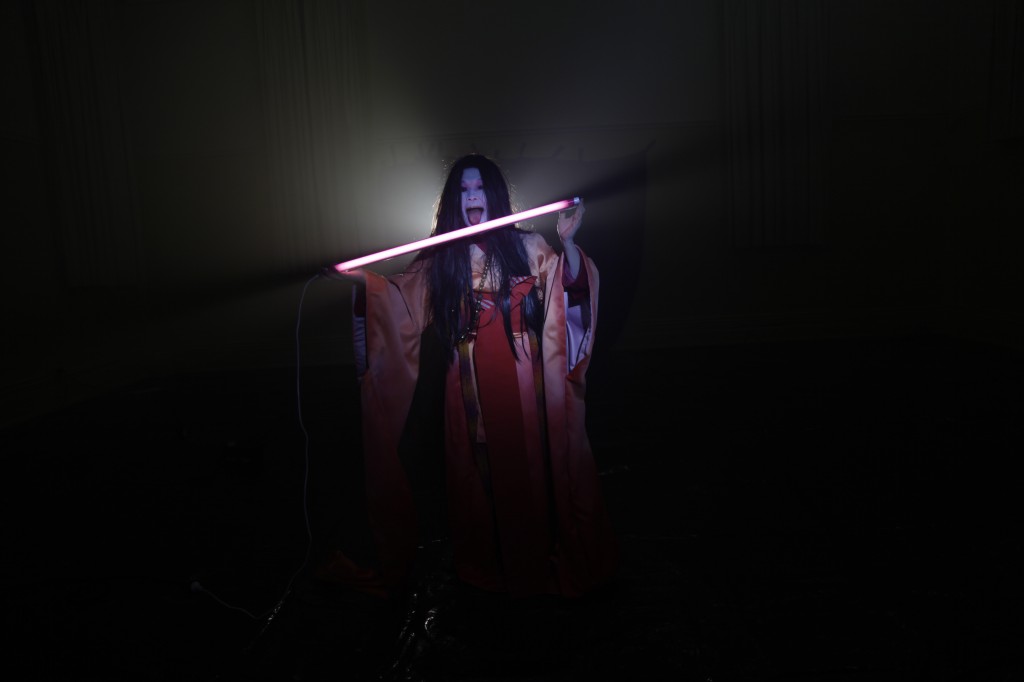
PERIL: Can you talk about your live-in performance and online conversation, and how your work explored the relationship between real and virtual worlds?
EUGENIA: As you mentioned, Stay Home Sakoku: The Hikikomori Project was both an online conversation and live stream, as well as a live performance work. Following on from the idea above – seeking to visualise the invisible as well as find a local or even global context and resonance for hikikomori, an otherwise culturally-specific phenomenon, I was interested in the possibilities for both connection and disconnection in online communication. Everywhere, social media and online communication is becoming more and more widespread. We’re spending increasing amounts of time online, which can only be impacting on the way humans interact with each other physically. I thought that this was worth exploring and unpacking: the real-world implications of virtual relationships.
In a related way, I guess the central tension in the project, the crux of it, was to make a work that was at once intensely private, yet totally public. The performance aspect was important – there had to be something ‘at stake’ for me and at least a perceived sense of danger or the unknown for the audience engaged with the project both on and offline. I took great inspiration from the one-year performances of Taiwanese artist Tehching Hsieh, in which he set himself unbelievably strict, monk-like guidelines for living and art for one year (during the 1980s). His life and art were one and the same for those years. For example, one year he lived completely outdoors, on the streets of New York through all four seasons, not allowing himself to go indoors or under shelters. For another work, he lived for one year in a small wooden cell he constructed in a gallery without any reading material, radio or television. A friend brought him meals each day and took away his refuse. He spent 365 days like this, with only himself and his thoughts for company. The intensity of these works and Hsieh’s commitment to exploring duration and the corporeal experience, but in a very private, almost Platonic way, were really important to me while conceiving my work – and while I was ‘on the inside’ too. Not as hardcore as Hsieh, I spent one week “living in” West Space, in a 5 x 5 metres (quite roomy by Tokyo standards!) gallery which I set up as a stylised bedroom/installation space. I also set myself strict guidelines: I could not leave the space, I could not speak verbally to anyone, I brought in no food (which meant I relied on the kindness of others for my sustenance – much like hikikomori), I only brought in essential items for a ‘digital life’, including my laptop through which I communicated with the outside work through the Stay Home Sakoku website or ‘hiki portal’ which had a live chat function and two live stream web cams. While I was tamagotchi-like, all in all, the real and virtual outcomes of the project were thoroughly entwined and that was the main premise of the project.
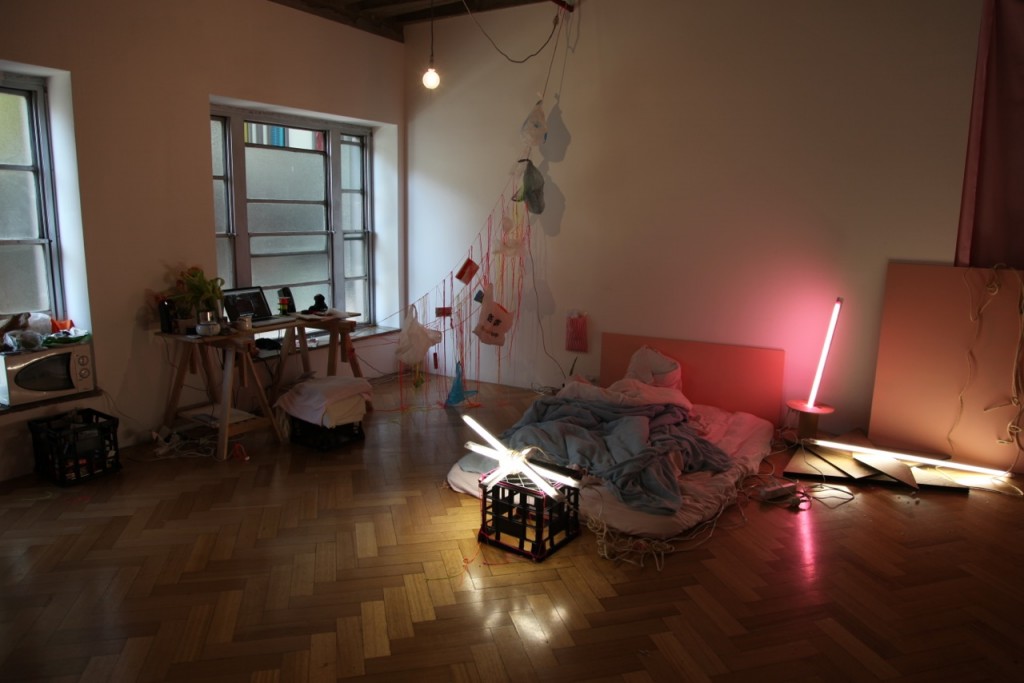
PERIL: How was online engagement with the outside world different during the day as opposed to the night?
EUGENIA: During the day, the gallery was open to visitors, so this was predominantly a time where I would hear human sounds. I would receive food, written notes and gifts and hear people speak to me from outside the room. There was a large group show on in the neighbouring gallery spaces (videos on loop – I memorised the soundtracks off by heart!) so generally there were people around. Online in the day, I would be chatting to people from different timezones: from Spain, France, Latin America and the US. I enjoyed this synchronicity across timezones from day to night – chatting to people before they would go to bed and vice versa. Time was very elastic over the week in the space – sometimes dragging, mostly exponentially fast since I was online and connected all my waking hours. I found the nights for me quite interesting – my body clock changed and I stayed up much later each night than I usually do, chatting to people in Australia as well as strangers and old friends overseas who were just starting their days. I could look across the laneway at a tall apartment building where I saw many people enclosed in their apartments, on their computers, somewhat isolated also.
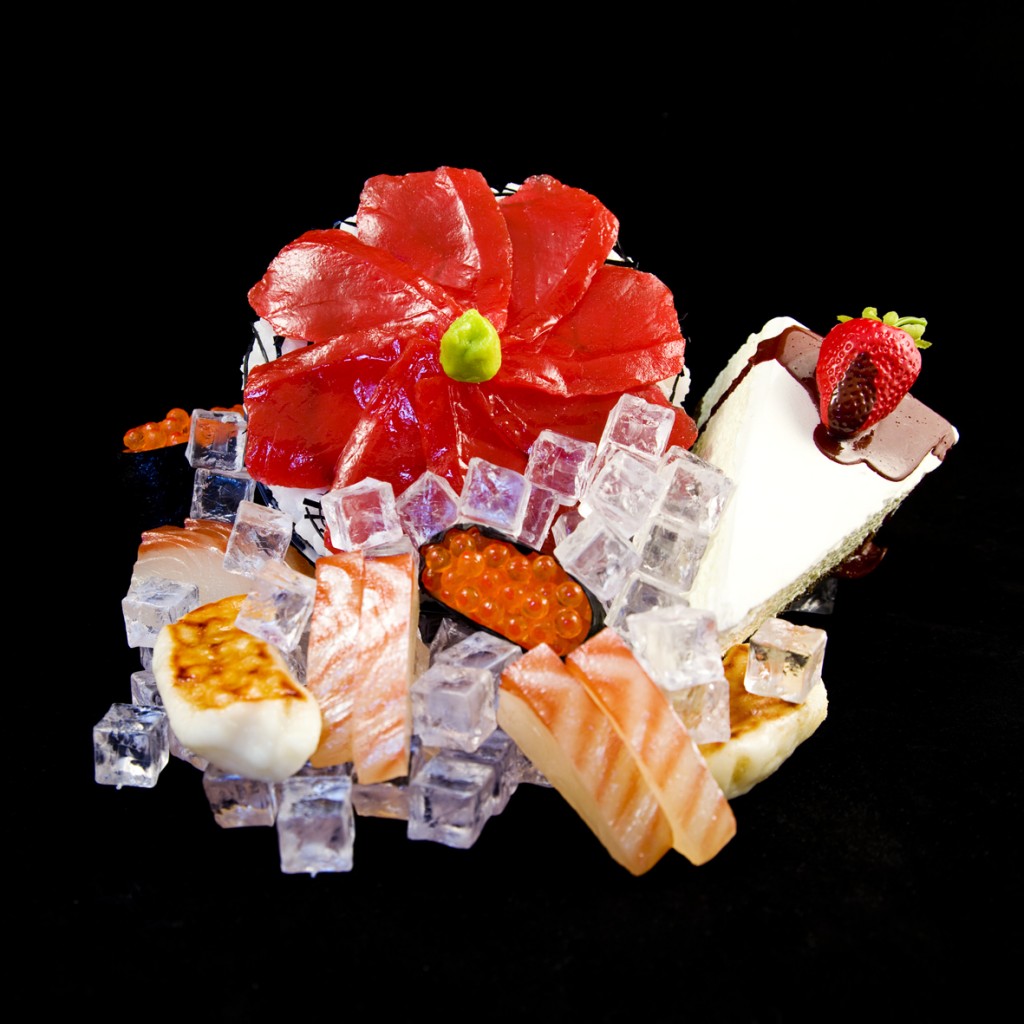
PERIL: Your only physical conduit to the outside world was a small slot in your sealed room through which strangers could offer you food and gifts. What was the most interesting gift you received during the performance and why?
EUGENIA: I’m just looking back at my gifts and my blog for the week. There were some incredible gifts and generosity – a tennis ball and some green plants from friends who gave me those to keep me sane, to give me something to do and focus on. I think perhaps the most interesting gift I received was a meal of home made pumpkin soup from a complete stranger who called himself Peggz (who I later met ‘on the outside’). Peggz and I had chatted online and he had sent me incredible YouTube videos of how to apply “manga eyes” makeup, and we’d talked about art and life. Peggz came by with a bag containing a Tupperware container of the soup in a bag and a kind note – the whole interaction felt quite intimate but still very much based on the unknown other. He could see me online (although I made it a point to have my hair covering my face throughout the performance week) but I had no idea who he was. Also before eating the soup it crossed my mind that I had no idea what was in the soup… maybe something weird, unsavoury? But I took a plunge and trusted in this person’s motives and generosity. The soup was delicious.
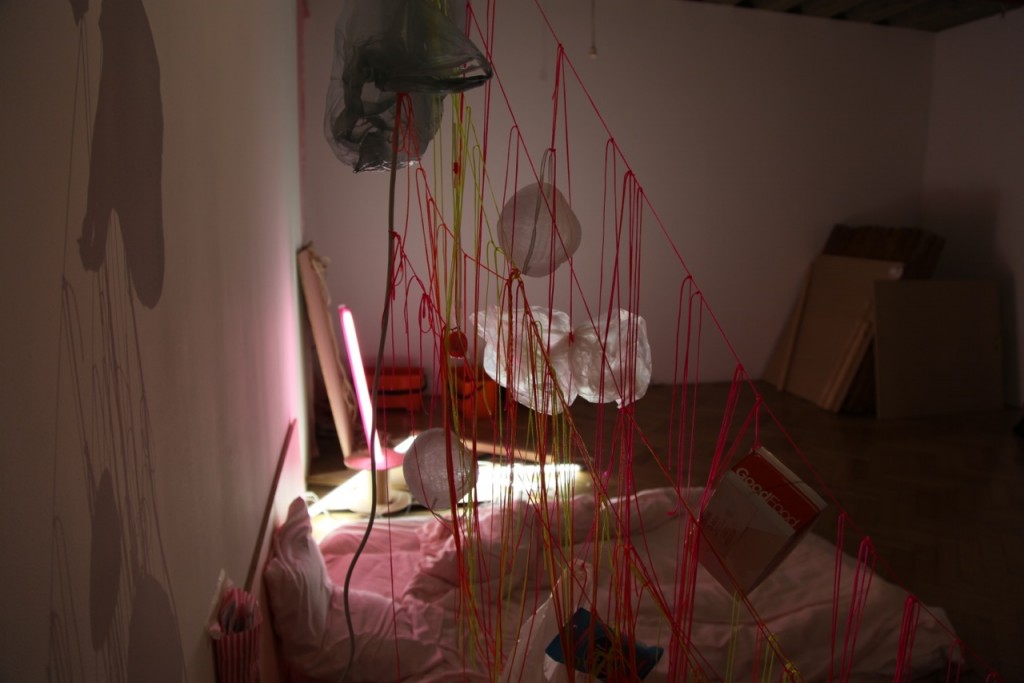
PERIL: One of the texts you read during your performance was Henri-Louis Bergson’s Time and Free Will. Can you speak a bit about the significance of this text in relation to some of the themes in your work?
EUGENIA: To be honest, my attention span was quite erratic while in the performance, so I only managed to get through a few pages before I abandoned any thoughtful analytic reading! But what I did take from the text, at least in a preliminary way, was Bergson’s ideas about duration and free will – that rather than a linear, fixed or located concept, duration is a product of time and consciousness and is heterogenous. So one week in a room was neither a long time, nor a linear experience, but one in which there were multiple trajectories and interactions, with people known and unknown in many timezones. This thought gave me some solace and made me think of the many hermits, monks and esoterics through the ages who have spent extended periods of time in isolation. There is no negation in duration.
PERIL: What are you working on in the future?
EUGENIA: At the moment, I’m one of several artists involved in the Put Up a Signal project, an online collaboration looking at screen-based culture between Indonesian and Australian artists. There are a number of outcomes this year (including showing the documentation of my ‘hiki-cam’ web cam footage from Stay Home Sakoku), but I’m looking forward to forging some new collaborations and developing new work for this in the new year. I just finished working on the inaugural Channels: The Australian Video Art Festival (which I co-directed along with artists Jessie Scott and Rachel Feery), a biennial festival of art dedicated to video as a mutant and ever-evolving medium. We will start planning the second edition next year. And in 2014, my main goal (apart from pumping out my first baby!) is to begin work on a new body of work exploring the historical and continuing impacts of gold, mining and immigration on the Australian cultural identity.

